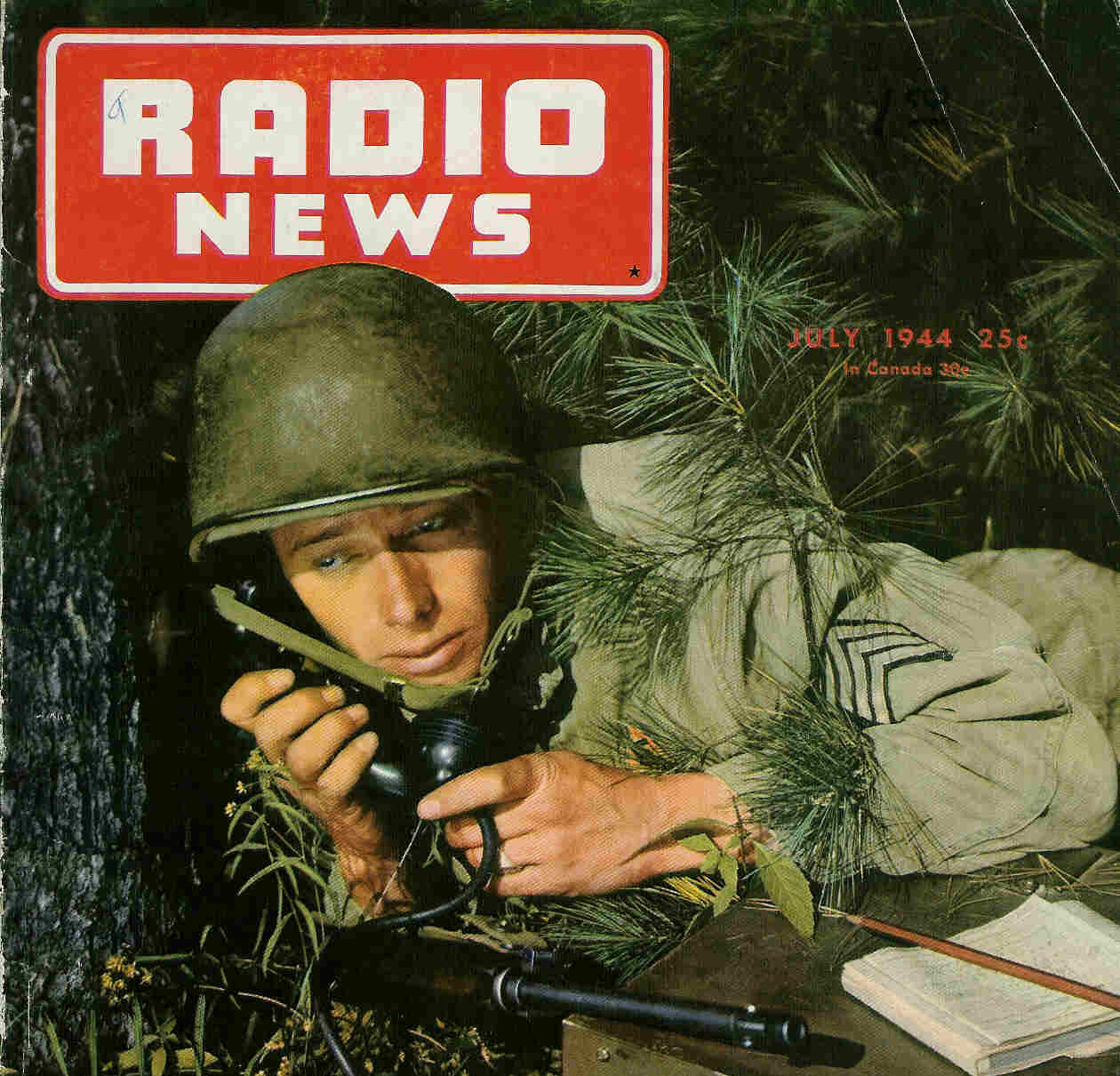
UPDATED 11/8/21
What’s happening at N6CC, both at the home QTH as well as off-grid Ops out in the boonies.
Type 12 / MAW Hearability Tests: In October 2010 we ran some propagation tests with 2 other Hams in the San Francisco Bay area. I was on Mt Diablo, appx 2800 feet AMSL, station 1 was on Nob Hill in San Fran, Station 2 was in Benicia, near the “mothball fleet”. I was running a Type 12 set on 144.440 mc AM,, stations 1 and 2 were running Marine Corps Type MAW manpack transceivers, both on 144.460 MC approximately. The frequency difference was a result of some crystals being slightly off frequency.
I was able to hear Stations 1 and 2, nearly full-quieting on the Type 12/R-19 receiver as it was tunable to their exact frequencies; my antenna was a 5/8 wavelength on the Bronco roof. Station 1 was running the MAW into a 2 meter ham “rubber duckie” antenna, a very inefficient antenna but he was on a roof with clear LOS to my position. He was appx 400 feet AMSL. He did not have LOS to Station 2. Station 1 could not hear me due to receiver problems with his MAW. Station 2 could hear me, we had a good LOS between us. He was using the correct MAW ground plane antenna on a short mast. Station 1 was about 27 miles west of me, Station 2 was about 17 miles north of me at appx 80 feet AMSL.
Incidentally, that LOS path was directly over the USS Iowa Battleship moored in the Suisun ready reserve fleet. We were inducing a little bit of RF voltage in her VHF antenna systems too, possibly stirring up some spirits lurking in the nervous system aboard “The Big Stick”. At some time in her life, she undoubtedly communicated using her TDQ on VHF with an MAW or Type 12 sets carried either aboard a Helo or possibly an L-Bird spotting her gunfire.
We repeated these tests one week later with Station 2 in the same place but a new station, Station 3 a few miles northwest of me in Walnut Creek, down in a foothill valley. He was running a ricebox on 144.440 MC AM and we had excellent comms from Mt Diablo.
PRC-6 / VRC-7/RT-70 Tests: We also tried 6 meters FM with VRC-7/RT-70 and PRC-6 tranceivers at Station 2 and Mt Diablo running on 51.0 MC FM. Good comms resulted, also to the ricebox at Station 3. These tests were also run using an PRC-6 on Mt Diablo and Station 2, good comms to/from both remote stations. The PRC-6’s were powered using the “French Army” DC-DC converter supply modules driven by internal D Cells.
When those tests were done, we also tried hitting Station 2 with a 3″x5″ standard military signal mirror over that 17 mile path. “Wow, really bright flashes !!”.
Conclusion. Comms were good considering the long range and the fact that the planning range of the 6 meter FM equipment was “a few miles”. The MAW’s and Type 12 transmitters need to be moved to 144.450, our chosen Net frequency but that will take some new crystals; on order. We will duplicate these experiments in the near future.
BT
NNNN

PRC-25 Hearability Tests: Back in June 1996 we ran some long range PRC-25 tests between Crandall Peak in the Sierra Nevada mountains and west to Hawk Hill in the headlands north of San Francisco. Crandall Peak is 5465 feet AMSL and Hawk Hill is about 600 feet AMSL. The path is 131 miles and would be optical LOS except for a 100 foot blockage in the Berkeley Hills, taking into account the curvature of the earth.
We maintained liaison on 2 meters FM simplex which worked great between Crandall Peak using 25 watts and a 7 element beam and Hawk Hill using a 1 watt walkie talkie and a 4 element yagi antenna. Turns out that kind of power and antenna gain on 2 meters wasn’t necessary.
Below is a shot of the station on the top of Crandall Peak in the Sierra’s. My buddy Leigh was assisting in antenna setup. Looks like our 7 element 2 meter Yagi on the AB-85 mast sections was not quite vertical yet! It is pointed off to the west towards San Fransicso, about 130 miles away. The AS-1729/VRC VHF whip is mounted on the spare tire carrier and it is wired to the VRC-7 / RT-70 set on 6 meters.

The PRC-25 made it from Crandall to the PRC-25 at Hawk Hill, both using the AT-271 fishpole antenna but the signal strengths were marginal.
Then Crandall Peak switched to an AT-984A, the 150 foot long wire. Aimed along the azimuth between stations and located about 6 feet above the ground, solid copy was maintained both ways.
TM 11-5820-667-12 (PRC-77) states that using those 2 specific antennas at each end provides a range of 17 miles, radio-to-radio. We got 131 miles over a nearly optical LOS. I’m sure we were getting some knife edge diffraction enhancement from the blocking ridge. The soil at Crandall was dry, loose broken rock with little vegetation; Hawk Hill is similar although finer soil and wetter close to the coast.
We also tried a VRC-7/RT-70 driving an AS-1729 mounted on the Bronco atop Crandall Peak. The circuit from the PRC-25/AT-271 was just in the noise, not usable although we did not try to enhance it by moving either station around a few wavelengths to see if that might be improved. They could not hear the half-watt RT-70. Later experience showed that repositioning could probably would have produced a few db difference either way.
Conclusion: The PRC-25 can greatly exceed the “nominal planning range” by a considerable amount if sited at optimal locations taking advantage of a nearly optical LOS path. Your mileage may vary…More tests to follow using the AT-984A at both ends over a longer path.
More MAW-Type 12 Tests: On 21 Jan 2011 We ran some more tests with Tom after he got his MAW re-tuned with the new crystals. These were replacements from ICM because the original TX rock was off frequency. I drove to the top of Mt Diablo, he set up in Benicia, just north of the mothball fleet anchorage – path was about 17 miles.
I could hear him on the Type 12 pretty much full-quieting when the data bursts were absent, but he could not hear me. I had previously installed a variable cap in the T-13A transmitter to pull the crystal right on to 144.450 MC.
Tom then listened to me with his HT on 144.450 (FM) and reported that he could hear me on that radio. After keying his HT to talk back to me, he reported that the MAW receiver seemed to come alive as indicated by his hearing a nearby data burst quite loud. He then listened for me, he could now hear me on the Type 12.
Weird…Seems his HT had somehow “shocked” his MAW receiver to life and it was now working… We then QSO’d successfully, MAW to Type 12 for awhile. One for The Gremlin Files… FINEX, back home to think about it.
RYRYRYRYRYRYRYRYRYRYRYRYRYRYRYRYRYRYRYRYRYRYRYRYRYRYRYRYRYRYRYRYRYRYRYRYRYRYRYR
Coastwatcher Ops: Spooner Cove on the Pacific Coast
We ran some Coastwatcher ops at the recent West Coast Military Radio Collectors Group event at Camp San Luis Obispo. This is a National Guard base on the West Coast adjacent to some great Pacific beaches.
We set up a GRC-9* at Spooner Cove, A TCS with an Inverted L antenna at MRCG Headquarters and another GRC-9 with a whip at a nearby location. The distance from the beach to Camp SLO was 9.18 Miles over dry, rocky hills. From there to Station Bravo was 3.91 miles and Bravo to Camp SLO was 5.74 miles.
Under the conditions at that time (appx 1000 local) the signal to noise of received signals was 2 to 3 times better on the whip than the AT-101 wire. It was running approximately northwest, broadside to Camp SLO, averaging about 6 feet off the sand.
AM phone Comms with the 15′ whip antenna on the beach were Q5 indicating groundwave propagation in this situation. CW signals were of course, much better. (*In this particular configuration the station is actually a GRC-87 rather than the more commonly referenced GRC-9.)

Coastwatcher Ops, Spooner Cove, San Luis Obispo
Above: Assistant Radioman powering the GRC-87 on the beach.

Coastwatcher Ops “On the Beach”
GRC-9 station set up alongside a creek heading for the sea.

GRC-9 Coastwatcher Ops
Above – The basic station setup. All Bikini sightings were encoded and transmitted back to Coastwatcher Control station “KEN” (Actually, it was “ED”.) Mission Accomplished.
BT
NNNN
——————————————————————————————————————————————————————————–
BATTALION COMMUNICATIONS CENTER: September 2010
We established a Batt Comm Cen at the fall rally of the Military Vehicle Collectors of California campout in the Sacramento River delta in Sept 2010. Photo below.

We operated a field telephone system based upon an SB-22 switchboard and TA-312 phones.

We had the following gear online and operational: SCR-284, GRC-9, R-392, GRC-109, PRC-25, Type 12 VHF AM, PRC-6, SCR-536 and three PRC-47’s (set up in a “Phased Array” configuration) See below..

We checked in to the West Coast Military Radio Collectors Group net on 3985 KC AM on Saturday night. We were heard in San Diego and into Oregon.

We even were able to call in Naval Gunfire Support from the USS Missouri operating in nearby waters.

The canteen radio replica from the Cabanatuan (Phillipines) POW camp was a crowd pleaser as usual.
RYRYRYRYRYRYRYRYRYRYRYRYRYRYRYRYRYRYRYRYRYRYRYRYRYRYRYRYRYRYRYRYRYRYRYRYRYRYRYRY
——————————————————————————————————————————————————————————
We had a great time at Camp Delta this week. There were approximately 200 military vehicles of all types in attendance. Fun crowd!
I had the following gear operational: PRC-25, GRC-9, Type 12, BC-683, GRC-109, RS-6, SCR-284, PRC-6, SCR-536, PRC-47 and an RT-70. . Chuck also set up a functional PRC-77 / SB-22 switchboard for a radio-wire integration demonstration and Vern demo’d his PRC2000 man pack on SSB.
We checked into the MRCG net on Saturday night via CW and got good signal reports all around. I worked lots of stations on 40 CW during the event too.
See posting on the Battalion Communications Center section on this website for more details.
RYRYRYRYRYRYRYRYRYRYRYRYRYRYRYRYRYRYRYRYRYRYRYRYRYRYRYRYRYRYRYRYRYRYRYRYRYRYRYRY
Military Radio Collectors Group: 2011 Camp San Luis Obispo Field Ops After Action Report
Comm FTX: There were at least 5 stations: N6CC/KJ6HYH, KG6UTS, WA6OPE/KD6TKX, W6TOM, N7EPI and SM5UR. That was 6 stations on about 6-8 different HF frequencies!

LZ-5150, Morro Bay
We heard everyone on HF at our location on the beach just south of Morro Strand Beach Park. (AKA LZ-5150)….Not sure where W6TOM was but we heard and worked him. We heard and worked WA6OPE on HF & 144.450 MC AM. He heard us on 51.0 with our PRC-25 (fishpole antenna) but not on our PRC-6. We did not hear his PRC-6. Morro rock was directly in the optical LOS path between our locations but should not have been an issue. (2 meters AM and FM worked OK – WA6OPE did hear my ARC Type 12 weak but readable… I heard his MAW). I don’t think we heard his BC-611 but I recall we did hear the MAB. Was a little distracted by the Cop at the time…
We also heard SM5UR on his Pogo Stick from CSLO (not strong but unmistake-able – the Swedish accent is good for an additional 2.7 db SNR !). , he heard us as well. We heard (and worked?) Ed on HF as well. I also heard and worked N7EPI’s TSC-15 rig at CSLO.. WA6OPE (or was it N7EPI) had the strongest HF signals at our site. Our site had some QRM – sounded like SCR noise and was fairly loud. We all seemed to be on different freq’s at different times – the Fog of War……
At N6CC: GRC-9 with G-43 hand crank genny, whip and ground radials, PRC-25, PRC-6, ARC Type 12 VHF AM. Jason got checked out on the GRC-9 BZ !!
Distances:
N6CC to WA6OPE (north of Spooner Cove AKA LZ-Cowabunga) = 6.85 miles mostly over water.
N6CC to KG6UTS, N7EPI and SM5UR (CSLO) = 8.98 miles
KG6UTS to WA6OPE = 7.78 miles.
The W6FM repeater covered the whole area well. Recommend we use it for liaison “next time”. 147.360 +split, 127.3 PL
Good fun…. Wait until next year! We should have a pre-deployment brief with a little more detail/planning next time…A site up in the mountains would be cool…Always willing to work some CW! I gotta get a 3885 crystal for the GRC-9 (1942.5).
June 2012: Ran some field Ops up in the Sierras with the GRC-109 on 40 meters CW. Battalion Comm Center – Forward this time…

Manning the GRC-109 at Batt Comm Cen Forward Operating Base
Above: HF Comms with the GRC-109 at Forward Operating Base Shangri La, in the Sierra Nevada Mountains, June 2012. Here working traffic on 40 meters CW down to LA. Very quiet site, nearest electrical noise is probably 20 miles from here.
————————————————–
N6CC participated in the annual Military Vehicle Collectors of California rally and camp out in Lodi CA, 17-20 April 2013. This is my 5th “deployment” of the Battalion Comm Center display and a good time was had by all. A bit simpler this year with less equipment (logistics constraints) but I had BC-683, GRC-9, PRC-10, PRC-25, GRC-109 and a PRC-6 running plus the VRC-7/RT-70 in the mobile. I used the GRC-9 with its simple whip antenna to work (among others) K6KPH at the Marconi Memorial station in Marchall CA, on the coast north of San Francisco. Not bad for about 10 watts to a short whip, mid day, 7050 KC, CW. Many visitors were at N6CC observing the fun.

Batt Comm Cen MRCG/MVCC April 13
Above: The basic setup, the GRC-109 set was off to the right next to the PU-181/PGC-1 gas generator.
Lots of interested visitors stopped by for a tour and demo. I had the California Highway Patrol tuned in with the BC-683 WWII Tank receiver and we ran radio checks with other Hams in the campground on 51.00 with the PRC-25 and PRC-6. Good fun…
——————————————————————————————————————————————————-
The camping trips continue. Some recent Ops. Also see the posts on the GRC-109, PRC-47 and RS-6 sets on this website for additional details on these particular radios and locales.

GRC-109 in the field
Above: Some radio comms with the GRC-109 from a new Op Area. Four days of CW fun up in the Sierra Nevada mountains. Lots of contacts: closest was 23 miles, farthest was 440 miles, all during the day with the GRC-109 on 40 meters.

PRC-47 in the field
Above: Same Op, this time running an USB PRC-47 for long range liaison back home. Dependable. Those two deep cycle marine batteries ran the PRC-47 for 4 days of casual ops plus two daily comm windows back home. Didn’t need to charge them with the Genny; mostly ran the TX at the 20 watt power setting. The receiver only sips about 600 milliamps.
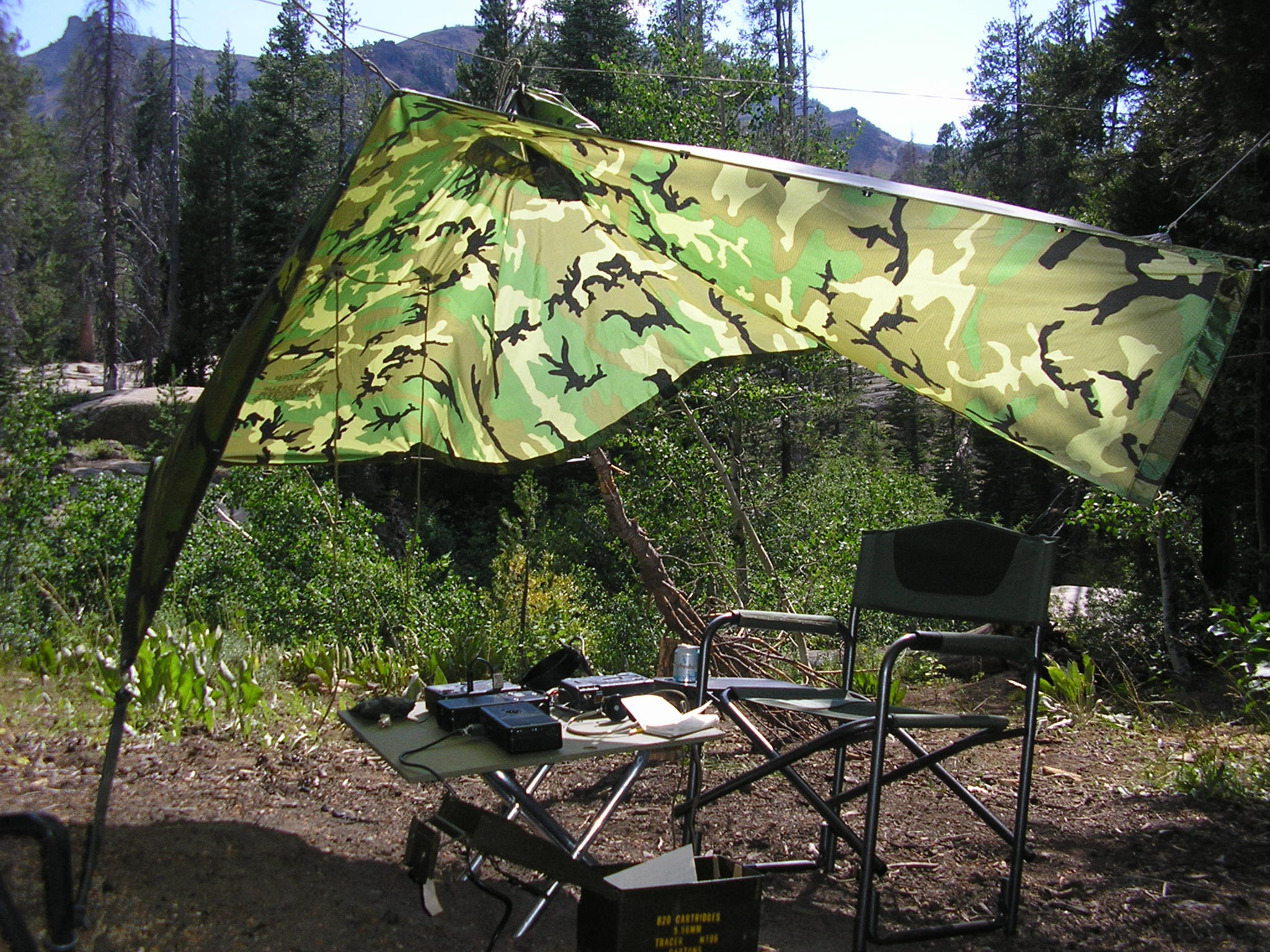
RS-6 CW setup in camp
Above, a simple hootch to get out of the high altitude sun. The RS-6 set was powered by the PU-181 generator, NVIS setup on 40 meters with a low dipole. Nice quiet location a LONG way from any cell phone coverage or repeaters.
———————————————————–
Mil Field Day, June 19, 2014
I operate remote “Field Day” many times during the year. Since I normally only operate military gear in the field it is a bit problematic to use this old gear on the crowded CW bands during the ARRL Field Day. So…I operate it on other days/weekends. It’s also a good time and place to experiment, especially with antennas.
Field Day is Field Day…When and where you are…
Below, some fun with the camera once I had finished the 12 Volt DC-DC power supply for the GRC-109 and started systems tests.. This setup needed a field test in the boonies to detect any final de-bugging that may be necessary. “Test it like you will be using it”….

12 Volt DC-DC Power Supply running the GRC-109 Receiver
The DC-DC power supply can run the receiver and the transmitter simultaneously. While using a small Gel Cell as above, the transmitter is powered by the G-43 generator with the battery only powering the receiver. That small battery will power both but you could not make many long transmissions before the little battery would need recharging. Solution: Use a larger battery like a Deep Cycle garden tractor or marine battery instead. With a small solar panel you are operational indefinitely.
OK, off to “Military Field Day” for a shakedown cruise, here about 40 miles north of Yosemite National Park in the Sierra Nevada Mountains, elevation 7550 feet AMSL..

Solar Powered GRC-109 in the Field

GRC-109 Solar Powered in Camp
Above: The first power supply field test operation from a remote “dispersed” campsite in the bush. A very quiet site probably 10 miles from the nearest paved road, electrical lines or cell-sites. Here running the small 20 watt solar panel charging the garden tractor battery. This powered the GRC-109 with the new DC-DC power supply for a 4 day operation in the mountains.
This setup would run a forward operating base indefinitely, its pretty quiet – and easy to set up and transport, at least while tailgate camping. The system worked well, plenty of capacity, worked a bunch of guys up and down the west coast on 40 meters CW during the day; 500 mile shots are no problem. Just a hint of power supply oscillator harmonics up in the HF band around 25 Kc apart and they drift around a little until the PS warms up for a few minutes – then they stay put – and are not a bother. Not much above the noise level. A snap-on ferrite choke on the 12 V power leads drops it considerably – but I forgot to bring that…Duh….
Signal reports all noted a “T9” CW note, no chirp, clix, crud or drift (crystal controlled of course).
The long orange power cord to the panel allows me to move the panel into the sun without having to move the equipment. I also brought along my homebrew charge controller with its metering capability. Not really needed since the 1 Amp full sun panel cannot overcharge this battery. But the metering makes it interesting…
GRC-109 Solar Powered in Camp
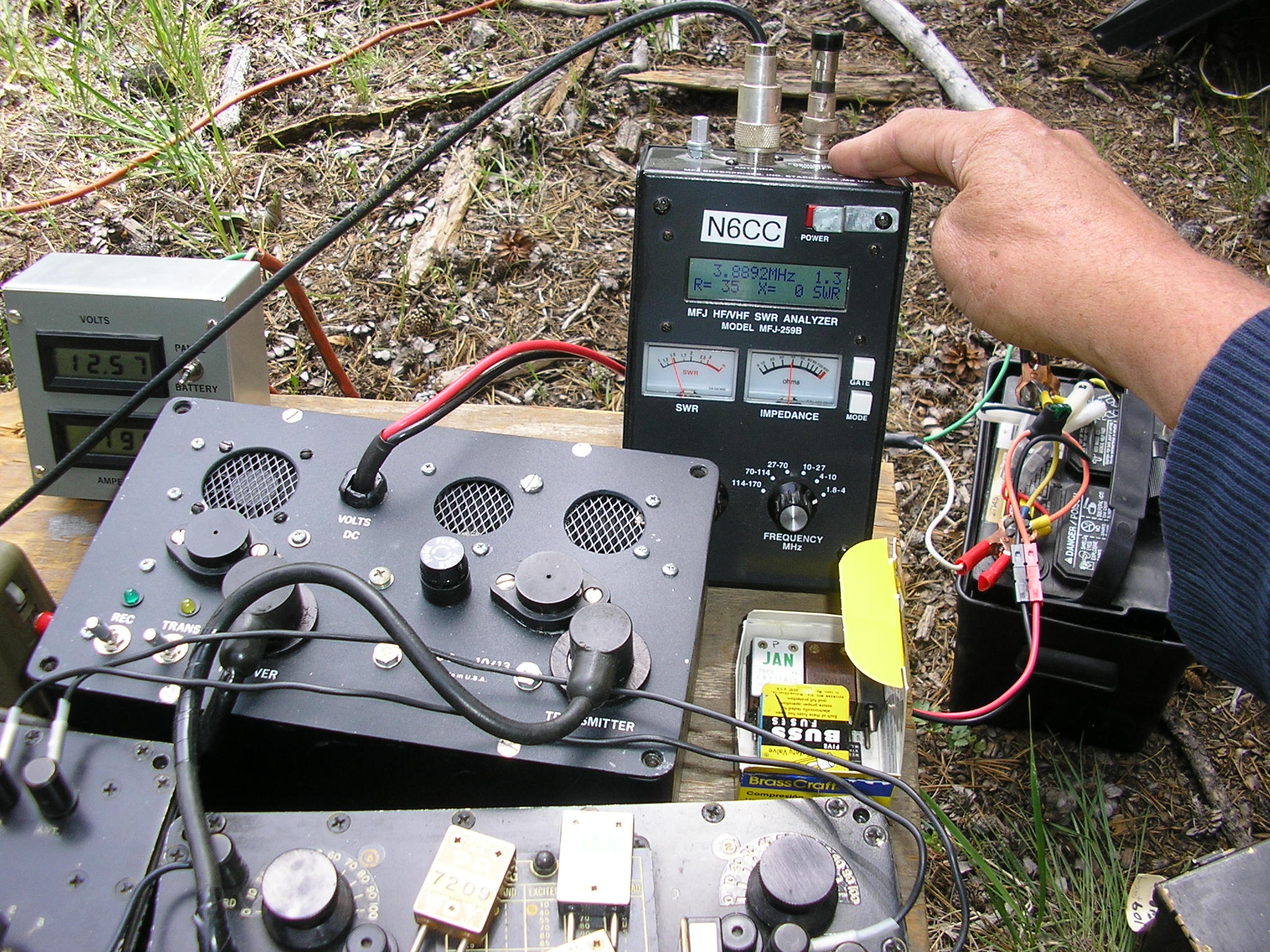
Low dipole impedance tests
Above: A little antenna test experiment in the boonies. I was running an 80 meter dipole up about 30 feet in the Ponderosa’s. Since it is less than half wave high (it was deployed for “NVIS”), the impedance was expected to be lower than the “ideal” 72 ohms. This is in the bottom of a thousand foot deep canyon, next to a perennial creek. I measured the impedance and found it to be 35 + j0 ohms at around 3890 Kc. (It was actually “cut” for 3550 Kc). So as expected, its impedance is lower than a free-space dipole. The resonant frequency was a bit higher than expected. Hmmmm More antenna Bugga-Bugga in the field…The resulting SWR was 1.3:1 and the GRC-109 had no problem with that.
It also performed well on 40 meters with the GRC-109 driving that much higher VSWR. Try that with a ricebox! LOL
I also had the GRC-9 as installed in the back of the Bronco – great for listening to the soccer scores from Radio Australia while snug in the sleeping bag at Zero Dark Thirty…
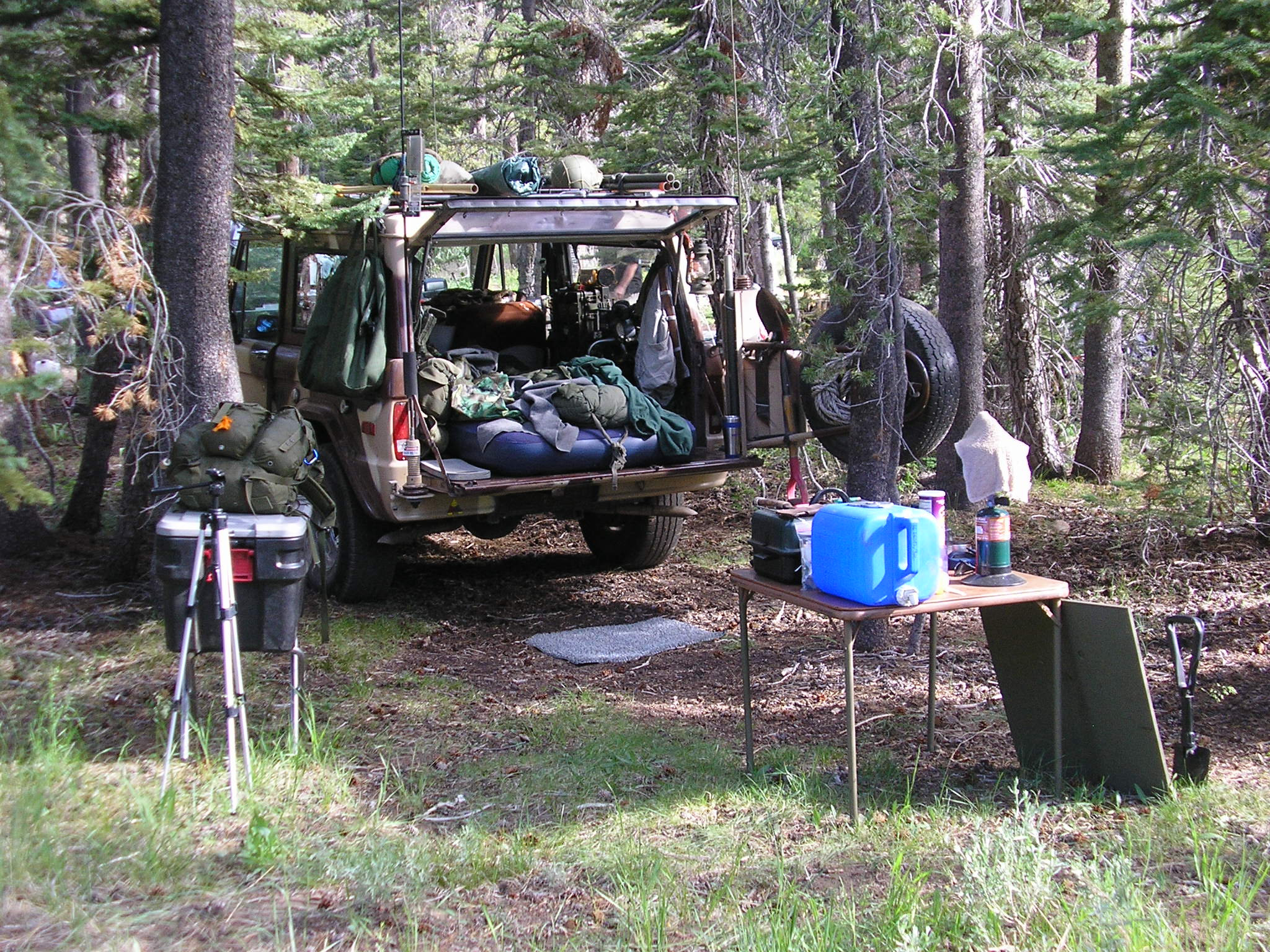
Dispersed Camping – Stanislaus National Forest
Another miserable day in the mountains….. CW while the Steaks and trout were cooking…..
I used to really like “Vintage Field Day” sponsored by Electric Radio, even though I never sent in a log (or tried to “compete”). I talked with Ray about why he dropped it, he said there seemed to be little interest. Seems to me there was more interest than submitted log sheets might indicate. Lets do some more of these – informally! We need to make some MRCG-MRCA cross-country contacts from the bush!
Or “Do It Yourself”. Military Field Day 2015:

AN/TRC-77 along with the AN/GRC-109
Working CW in the bush with the TRC-77 and GRC-109 sets.
(A little more info on the DC-DC power supply and the GRC-109 in general in the Military Tactical Radios category on the website.)
——————-
Veterans Day 2015: Our local veterans groups set up a “do it yourself museum” in the Veterans Memorial Building. So I set up some operational equipment and ID placards. Not shown is the SCR-284 that the kids loved to crank. I had set up a URM-25 signal generator “transmitting” on HF. This modulated by a CD player running 5 letter cipher groups in 20 WPM morse for their listening enjoyment. Well attended, good fun.

Veterans Day 2015 Radio Display
Above: The RS-6 in a period suitcase, EE-8 Field phone, MAB, BC-611, LM-14 and Command Set system on this side.
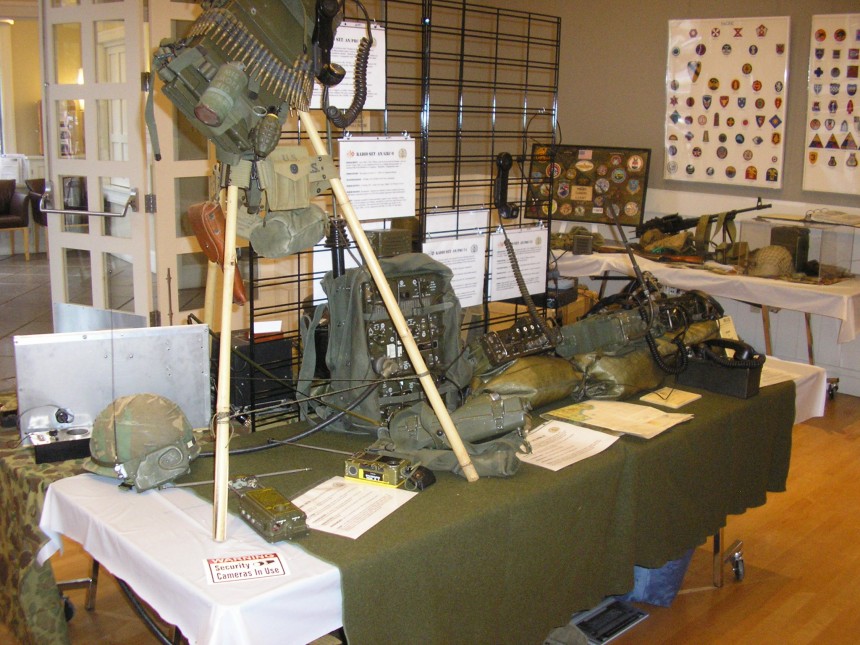
Veterans Day 2015 Radio Display
Above: A PRC-10 on a bamboo display tripod, PRR-9 on a helmet, URC-64, URC-4, GRC-9, PRC-6, PRC-25, PRC-74, TA-312A, TRC-77.
Lots of interest in this stuff, many knowledgeable Vets stopped by to pass along sea stories..
Then off to the lake with the AN/TRC-77 CW set. Kept in touch with friends on 80/40 meters, solar powered indefinitely!

TRC-77 Ops at Lake Berryessa
Then off to more Boondocks Ops, this time with the AN/GRC-109 CW set. A very remote off-grid campsite.

AN/GRC-109 station at a remote off-grid campsite
Below is another field Op setup under a poncho hootch. We had the TRC-77 and GRC-109 CW sets up and running. Got Comms? Yes….

TRC-77 and GRC-109: Bush Communications
Yet another camping trip with Comms.

Tailgate TOC; HF CW in the Bush

GRC-9 Ops Fixed Mobile
Below: Another recent Military Radio FTX: Forward Operating Base Herring Creek with the PRC-174 on CW, AM and Radioteletype. FOB up in the Sierras in October 2021 with friends. A little snow at 6500′ from an early fall storm. The PRC-174 is propped against the tree with the little table at the Tactical Operations Center (and chow hall…)

FOB Herring Creek – A little snow in early fall
Below: Monitoring the MRCG Military AM Phone net on 3985 kc at 1800 local time. Good signals up here – no noise.

PRC-174 Portable on CW

PRC-174 RATT in the field
Above: The PRC-174 running Tailgate Teletype. The Inverted L antenna heading up into the big Ponderosa pines.
BT
NNNN
AWESOME stuff……………….Oh the memories !!
Ran across your site the other night. Very nice! I made some training visits to an MIUW Reserve unit to give radio training with my own Harris RT-1446 from CAP days. I was an Active Duty pilot, then into the Reserves (including SPECWAR Unit) as a two-way radio design engineer (UHF Repeater). Into the Field with the MIUW Unit to give HF comms training to their RMs. Used two 75′ long rolls of aluminum foil as the four-radial full sized ground-laid counterpoise for the 32′ whip. You can see the RM’s rolling their eyes and fingers confirming my O5 double lobotomy!
Air Force Aircraft 6005 on 11175 kHz enroute Ascension Island just off Brazil called every AF ground station around the world, then “any aircraft this Net?” NO ONE answered him! Being a pilot, I knew he wanted to confirm his HF was working before going out over open ocean. I made a call sign, “Aircraft 6005, this is Mike Uniform Whiskey, over.”
“MUW, thank gawd SOMEBODY can hear us!” The RMs were almost genuflecting, ‘Nobody in the world can hear 6005 except the crazy Commander and his 75’ diameter ‘Bomb HERE’ shiny aluminum “X”. But we believe, WE BELIEVE! ‘ 5000 mile hop from OH.
de N9ACC
Hey Sailor! Thanks for checking in. Yep, I had some fun in the Canoe Club with my ham interests as well.
We (MIUW AN/TSQ-108A) deployed with the RT-1447 and Amp (URC-119) and they worked well but the 32 foot whip was not very good for the regional comms we needed – out to about 300 miles. It was sitting on a huge steel deck on an oil terminal out in the Gulf so the grounding was otherwise excellent. I rigged a low horizontal wire which worked great over that intermediate distance. Otherwise the gear worked fine, even on CW…
Thanks for checking in & thanks for your service..Tim
Very nice website.
i really enjoy watching your activity.
73’s
9h1es
Hi Fortunato – Thank you for checking in again. Well I try to get out and play with radios, especially while camping. Have you gotten your ARC Type 12 going? With little Ham activity on 2 meters AM they are still fun for listening to aircraft…
Thanks and take care!
Cheers, Tim